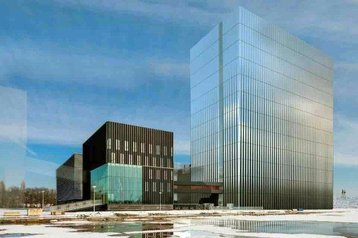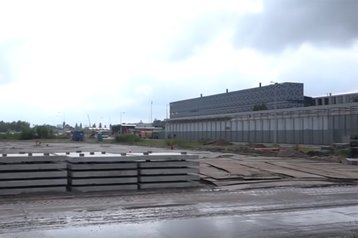Everyone knew Equinix was growing fast in Amsterdam - but last week the company revealed plans for a monster ten-story facility there, even in the midst of other expansion in the up-and-coming hub.
The US-based colo giant had three data centers in Amsterdam, and a vacant lot has been slated for “AM4” for years. But before the project started, Equinix acquired a bunch more data centers with the purchase of Telecity. So AM4 has been overtaken by AM5 to AM8, before work even began.
Piling it on
The numbering leaves Equinix’ European president Eric Schwartz quietly pleased. He’s managed to juggle the sequence so AM4 is still going to be AM4, and some of the Telecity buildings have managed to keep their Telecity numbers. He’s also excited to be getting started on what will be a pretty ambitious building project.
“We’re building on land we lease from the University of Amsterdam, and we wanted to avoid a visually boring row of similar buildings,” he told DatacenterDynamics. “AM3 is three stories, and AM4 will be ten stories high, giving more massing and variation. We’ve been working for a while to get it lined up and get the permits in place.”
Foundation work has been going on for some time, and is somewhat constrained, as the site (below) is right next to AM3, and has a security moat on two other sides. Amsterdam University stipulated there could be no security fences or barbed wire in an area designated as a science park, so Equinix dug “quite a large moat,” Schwartz explains, around AM3 and the AM4 plot.
The moat and the building limited the places where Equinix could place the 50m pilings required to build on Amsterdam’s soil, and the soil conditions added to the complexity: “Because of the soil conditions, we’ve drilled the piling down 25m, then welded another pipe on top and gone another 25m down,” he told us. “There is so much pressure at 50m, you have to fill the pipe with concrete as you go, or the pressure will crush the pipe.”
I look at the velocity of adoption of cloud, in or out of the EU. Those tech trends are taking place across the world, regardless of Brexit. So I am optimistic
With the piling done, progress will be more visible: “We are just now starting to come out of the ground, and that’s the exciting part!”
But, with another four data centers added to its Amsterdam estate, why does Equinix need to build AM4? Schwartz explains that the Telecity facilities have arrived with customers in place, and AM3 has been filling rapidly. “When we could see we were going to fill AM3, we started construction. We expect to fill AM3 in Q2 2017, and have AM4 open by then.”
Exchange of Exchanges
So what about the “new” data centers Equinix has acquired? Telecity had six facilities in Amsterdam, but the European Commission ruled that that was too many for Equinix to acquire, so two were sold off to Digital Realty. Of the remaining four, two are conveniently on a campus in the South East, where Equinix already had two facilities.
But location isn’t everything. Equinix bases its business model on connectivity, dubbing its sites International Business Exchanges (IBXs), with fast connectivity between any customers who happen to be business partners. If the IBX sites are that much better than the competition, how much work is involved in upgrading an acquired site before it can be rebranded?
“The acquired facilities will be branded IBX,” Schwartz assured us. “A number had been built to a consistent design, consistent with how Equinix is building its sites. We may have to invest in putting in more interconnection between them.”
As a quick summary, three of the acquired sites were built by Telecity, while the fourth was originally owned by the long-ago acquired Redbus.
“We’ll be doing physical checks and analysing the infrastructure and design to find out what we need to do to improve the performance and stability, and provide monitoring and redundancy,” said Schwartz.
“We are in the process of doing upgrades,” he went on. “But all in all, we are very pleased with the quality of the facilities. The amount of investment we are having to make to convert them to IBX facilities is very reasonable.”
A big help in this process will be the Telecity engineers. Schwartz would happily keep all of them, except where they are required to move with the EC divestiture plan: “Our goal is to retain the entire Telecity workforce. We need more staff, and the Telecity people have good levels of expertise.”
The Facebook of data centers?
How important is the IBX model? As businesses are tempted in by the prospect of better connections to other Equinix customers, it is tempting to compare it with social networks, where Facebook has wiped out early contenders like Myspace simply because of the gravitational pull of its existing subscribers. Does he want Equinix to be the Facebook of colocation?
“The scenario you lay out is flattering,” he says. “I appreciate the metaphor and we are certainly enjoying success, but we are a long ways away from the sort of endgame you are describing. One of the quickest ways to destroy customer relationships would be to adopt a position of arrogance.”
He points out that other players like Digital Realty are now pitching a similar concept. “Certainly our business is to grow the interconnection density of the sites, and have more customers using that, but we have sold assets to Digital Realty, who are positioned to do something similar. Our goal is to bring as much interconnection density into the Equinix site as we can, but that’s only a subset of the data center market.”
And there’s room in the market for different and competitive business propositions: “There’s enough activity that we have plenty of opportunity.”
London falling?
We ask Schwartz about the effect of Brexit on Equinix’s European business, but it’s too soon for any big changes of plan, he says: “I’m no more of a political science expert than anyone else, but we are completing the expansion of London6, which is a $42m project, with 1385 cabinets. It was launched before the Brexit vote, and it is reasonable to finish it. While it is early days, we are seeing good activity from customers.
“Everyone is concerned about it,” he says, but he believes the UK economy will continue as a strong economy, with the British government doing what it can to stimulate it. “In the fundamentals of who is there and what they are allowed to do, nothing has changed yet. The European Union has an interest in not disrupting its own capital market.”
It is an inappropriate and inexact metaphor, but the data center industry weathered the 2008 financial crisis, he said. At that time some people paused expansion projects, but Equinix expanded in the UK with the financial industry as a core element.
“Brexit is not 2008 by any means, but it is a new circumstance to deal with,” he said. “I look at the velocity of adoption of cloud, in or out of the EU. Those tech trends are taking place across the world, and will drive requirements for capacity at the edge, regardless of Brexit. So I am optimistic.”
The Telecity deal and its fallout gave Equinix another facility in a different hub, Paris, which is also experiencing growth. Schwartz is pleased with that: “Our facilities in Paris were largely full, and we were diverting demand to other locations. Telecity brought us other capacity in the vicinity. Stay tuned!”



